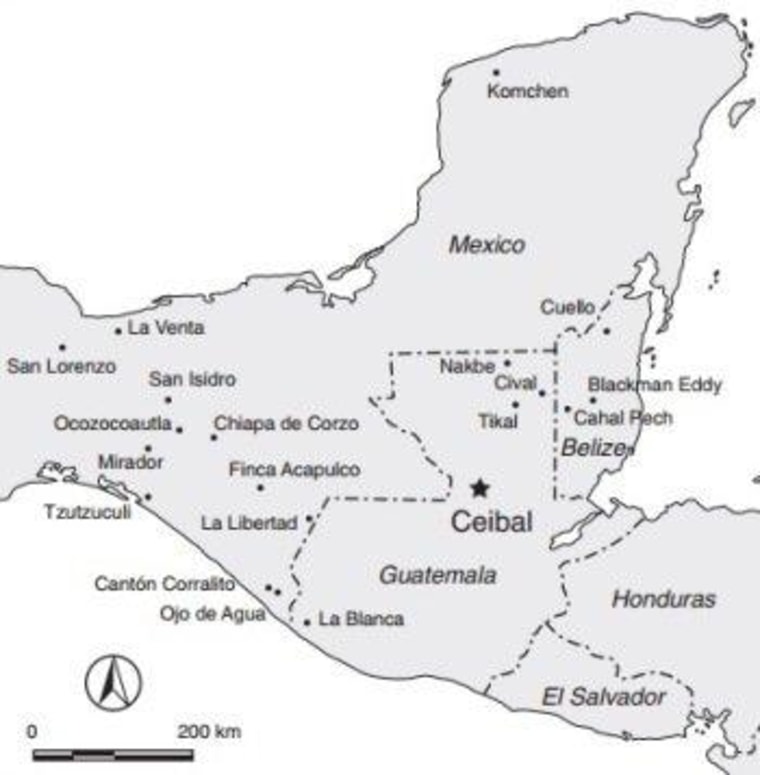Archaeologists say that ceremonial structures unearthed in Guatemala are centuries older than they expected — and that the findings point to new theories for the rise of Maya culture.
"The origin of Maya civilization was more complex than previously thought," the University of Arizona's Takeshi Inomata, lead researcher for a study appearing in this week's issue of the journal Science, told reporters on Thursday. Even though all this happened 3,000 years ago, the findings could provide fresh insights about social change in general, he said.
The Maya had their heyday in Mexico and Central America between the year 250 and 900, but the roots of their culture go much farther back. There are several schools of thought about how their distinctive culture arose: Some archaeologists say the central features of Maya cultural life, including grand ceremonies centered on broad plazas and pyramids, were borrowed from Mexico's older Olmec civilization. Others say those features arose internally, without much outside influence.
Inomata said the excavations at Ceibal, in Guatemala's Maya lowlands, suggest a more complicated scenario. Over the course of seven years, he and his colleagues dug down more than 50 feet, analyzed the layers of sediment, and did scores of radiocarbon-dating tests to trace the evolution of Ceibal's structures. They concluded that Ceibal's Maya rulers started building ceremonial plazas and platforms around 1000 B.C., and had turned those structures into a central pyramid and plaza by 800 B.C.
That would mean Ceibal's residents were developing the architectural and religious hallmarks of Maya society before the first appearance of those hallmarks in Olmec society, at La Venta, hundreds of miles away on Mexico's Gulf Coast. La Venta's ceremonial structures have been dated to about 800 B.C.

Other Maya settlements were building such structures around that same time, although they weren't as developed as Ceibal's. A wide spectrum of Mesoamerican communities — for example, settlements in central Chiapas and those on the southern Pacific coast — may have had a lot of important interactions with Ceibal and other communities in the Maya lowland during this period, Inomata said.
He stressed that the Olmec almost certainly influenced Maya culture during the centuries that predated Ceibal's rise. For example, there's evidence that an Olmec center near San Lorenzo was dominant well before Ceibal's residents began building their ritual structurs. However, Inomata said, "San Lorenzo didn't have the kind of ceremonial complexes that we're talking about."
The period from 1000 and 800 B.C. appears to have been a key turning point for Maya culture. There may have been a "power vacuum" between the fall of San Lorenzo and the rise of La Venta that gave early Maya communities the opportunity to experiment and develop cultural innovations, Inomata said. "We are looking at major change in this period, and that happened really in the absence of a very strong Olmec center," he told reporters.
The construction of Ceibal's ceremonial complexes would have required the participation of the whole community, said the University of Arizona's Daniela Triadan, who is a co-author of the Science paper as well as Inomata's wife. "Some people might already have had a special position in the community, and they were most certainly people with specialized ritual knowledge. This indicates that the transition from a mobile hunter-gatherer and horticultural lifestyle to permanently settled agriculturalists was rapid," she said.
What drove that rapid change? The research team is still looking into potential environmental factors, but Inomata speculated that the cultivation of maize — that is, corn — may have been decisive. "There may have been a major increase in maize production, which may have been a threshold in terms of the development of cultural elements," he said.
"This is not just a study about this specific civilization," Inomata told reporters. "We also want to think about how human societies change, and how human civilization developed. What we are seeing here is that major renovation and change can happen through the interaction of various groups. It doesn't have to come from powerful, major political centers. That's one important implication that we are getting."
More about the Olmec and the Maya:
- Olmec influence stretched hundreds of miles
- Maya doom teaches climate lesson
- Cosmic Log archive on Maya culture
In addition to Inomata and Triadan, the authors of "Early Ceremonial Constructions at Ceibal, Guatemala, and the Origins of Lowland Maya Civilization" include Kazuo Aoyama, Victor Castillo and Hitoshi Yonenobu.
Alan Boyle is NBCNews.com's science editor. Connect with the Cosmic Log community by "liking" the log's Facebook page, following @b0yle on Twitter and adding the Cosmic Log page to your Google+ presence. To keep up with Cosmic Log as well as NBCNews.com's other stories about science and space, sign up for the Tech & Science newsletter, delivered to your email in-box every weekday. You can also check out "The Case for Pluto," my book about the controversial dwarf planet and the search for new worlds.
